Nordic PMICs – Integrated Solutions for Modern Power Management
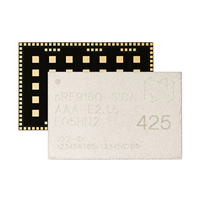
Nordic PMICs – integrated solutions deliver advanced power management for today’s compact electronics. These PMICs combine multiple power functions, reducing the need for extra components and saving valuable board space. Efficient power management becomes crucial for battery-powered applications such as Nordic's nRF52 Series SoCs and nRF9160: This is Nordic's cellular IoT solution. Studies show integrated PMICs can extend battery life by about 20% and reduce solution size by 60%. The integrated approach in power management simplifies design and speeds up development for engineers working on battery-powered applications and IoT devices.
Key Takeaways
Nordic PMICs combine multiple power functions into one chip, saving space and extending battery life in compact devices.
These integrated solutions simplify device design and speed up development with easy-to-use software tools and configuration options.
Nordic PMICs offer high efficiency and flexible power management, supporting various battery types and reducing energy waste.
Advanced safety and monitoring features in Nordic PMICs protect devices and ensure reliable operation in wearables and IoT products.
Using Nordic PMICs helps engineers create smaller, smarter, and longer-lasting electronics for modern applications.
Nordic PMICs – Integrated Power Management IC
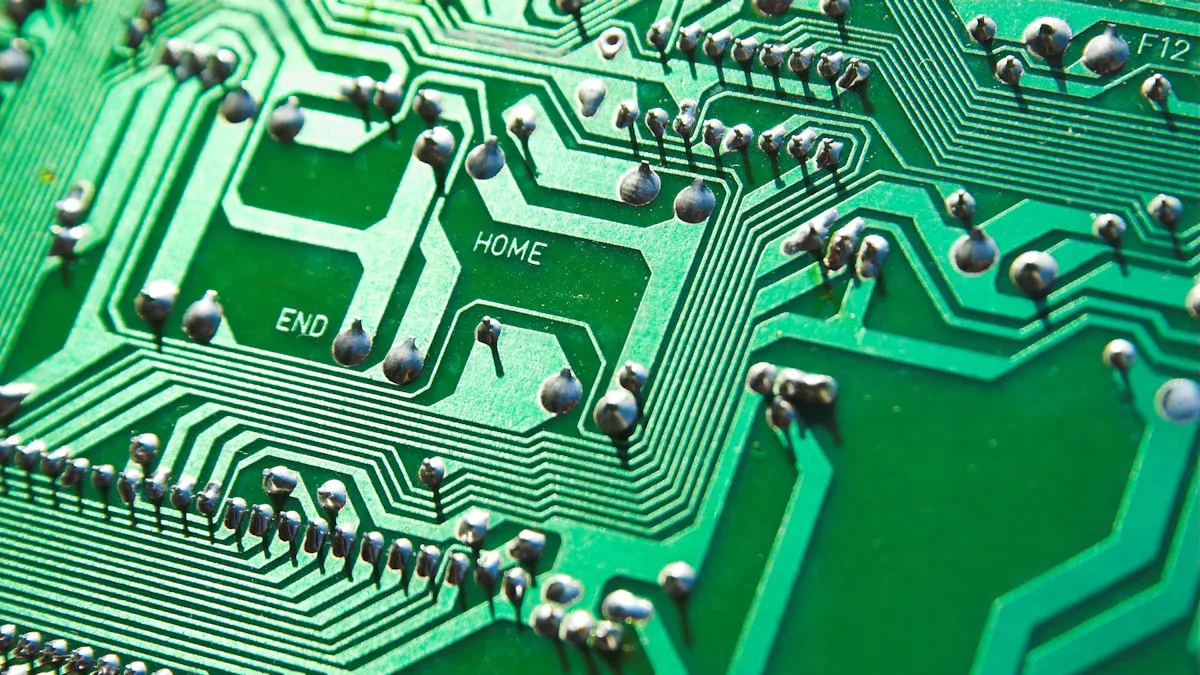
What Is a PMIC?
A PMIC, or power management integrated circuit, is a specialized chip that controls and distributes electrical power within electronic devices. These circuits manage multiple power sources, regulate voltage levels, and ensure stable operation for all components. In modern electronics, PMICs play a vital role in maintaining efficiency and reliability, especially in devices that rely on batteries.
Industry benchmarks show that PMICs must handle multi-domain power management, often with strict isolation between safety-critical and non-critical functions. They include on-chip monitoring and power sequencing to keep voltage regulation stable. For example, automotive systems require PMICs to meet safety standards like ISO 26262 and to provide real-time fault monitoring. Advanced PMICs also support dynamic voltage and frequency scaling, which helps optimize power consumption based on system demands.
Nordic PMICs – integrated solutions stand out in this field. The nPM1300 PMIC, for instance, provides efficient power regulation for Nordic’s SoC and SiP series. It supports battery charging and works with Nordic Fuel Gauge for accurate battery state-of-charge estimation. The nPM6001 offers six independently controlled power rails, supporting complex applications that need multiple voltage domains. These features make Nordic PMICs – integrated solutions ideal for compact, battery-powered devices.
PMICs are essential for modern electronics, from wearables to automotive systems. They ensure devices run efficiently, safely, and reliably.
Benefits of Integration
Integrated power management brings several advantages to device design and operation. By combining multiple power functions into a single chip, Nordic PMICs – integrated solutions reduce the need for external components. This approach saves valuable board space and simplifies the overall design process.
Space and Cost Savings: Integrated circuits minimize the number of separate chips on a board. This reduction leads to smaller device sizes and lower manufacturing costs.
Efficiency and Flexibility: Nordic PMICs – integrated solutions allow developers to tailor power configurations for specific applications. The nPM2100 PMIC, for example, features an ultra-efficient boost regulator optimized for primary-cell batteries. This design extends battery life and supports efficient power management for portable devices.
Simplified Development: Integrated power management ICs come with comprehensive software support and configuration tools. Nordic’s solutions, such as the nPM1100 Evaluation Kit, enable straightforward evaluation and real-time performance monitoring. Developers can test power management efficiency without custom hardware, speeding up the development cycle.
Enhanced Reliability: Integrated circuits offer on-chip monitoring, power sequencing, and fail-safe mechanisms. These features help maintain stable voltage regulation and protect against faults like voltage drops or overheating.
Nordic PMICs – integrated solutions also support seamless integration with cloud services and development tools. For example, the nRF9131 mini SiP simplifies hardware design and increases integration by combining a cellular IoT modem and RF front end in a compact package. Its compatibility with Nordic’s software and reference designs further eases development.
Power Management Integrated Circuits in Modern Devices
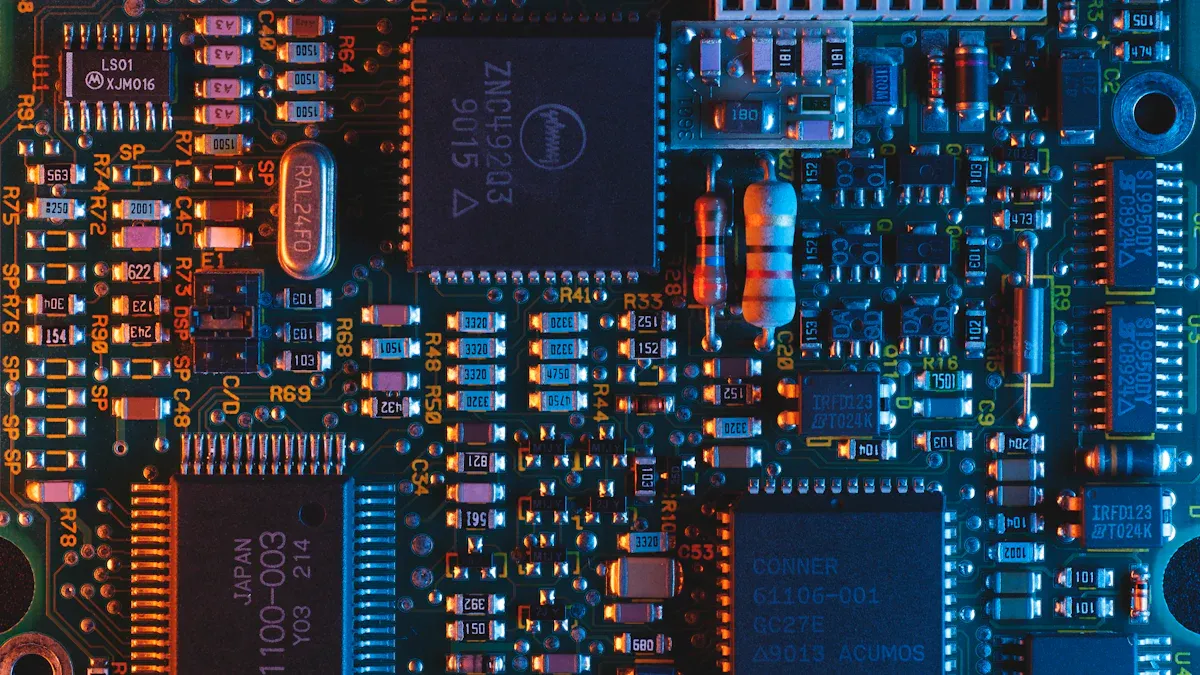
Efficiency and Flexibility
Power management integrated circuits play a key role in modern electronics. These circuits help devices use energy more efficiently and adapt to different power needs. The demand for PMIC solutions continues to grow as more people use smartphones, tablets, wearables, and IoT devices. Market research shows that advanced features like fast charging, adaptive voltage scaling, and power optimization drive this trend. Companies such as Texas Instruments and Analog Devices invest heavily in new PMIC technologies to meet changing requirements.
Independent performance tests highlight the efficiency and flexibility of modern power management. For example, the HR121x digital power controller uses both analog and digital design. It allows engineers to program key settings, such as switching characteristics and operation modes, using a simple interface. Automated test systems collect real data on efficiency and performance. These tests show that the controller maintains high energy efficiency across many conditions. This flexibility helps devices meet strict regulatory standards and adapt to different applications.
Devices with flexible power management integrated circuits can adjust to changing workloads, save energy, and extend their operating life.
The PMIC market continues to expand worldwide. The following chart shows the growth in market size and share for different segments:
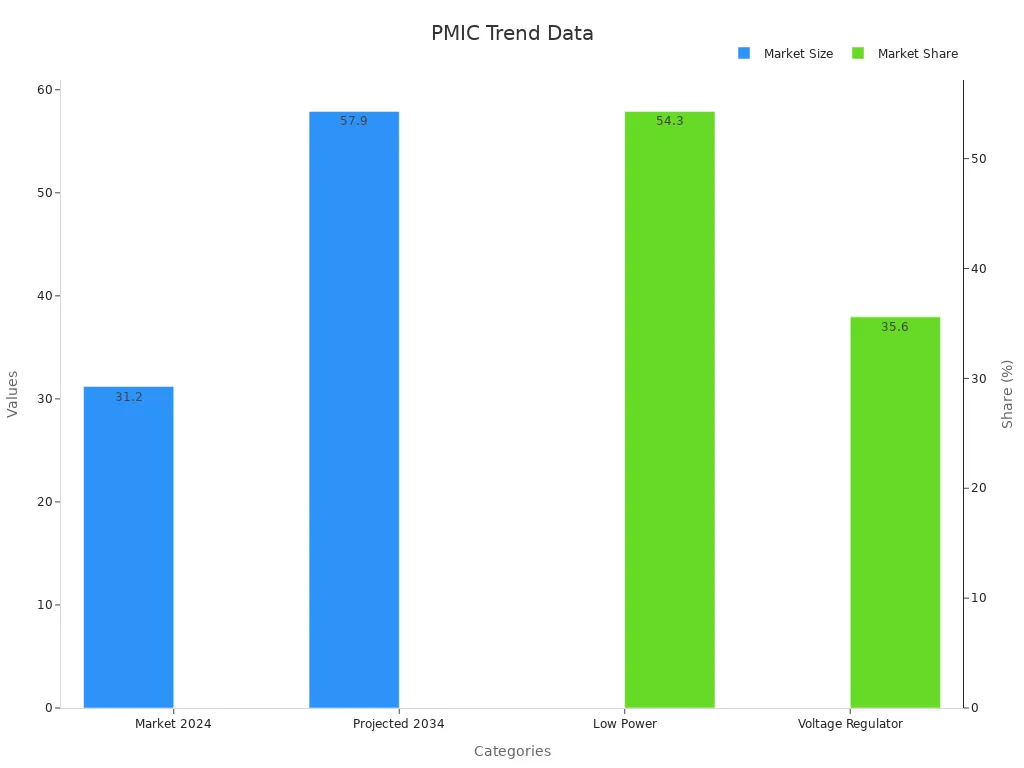
Battery Life and Space Saving
Battery life remains a top concern for users of portable electronics. Power management integrated circuits help address this by improving energy efficiency and reducing wasted power. PMICs combine several power functions into one chip, which saves space on the circuit board. This integration allows designers to create smaller, lighter devices without sacrificing performance.
A closer look at the market data reveals why PMICs are so important:
Attribute | Detail |
|---|---|
USD 32.9 billion | |
Forecast Market Size (2031) | USD 56.2 billion |
Voltage Regulator Segment Share (2022) | 31.2% |
Consumer Electronics Segment Share (2022) | 32.4% |
Regional Leader | Asia Pacific (36.9% share in 2022) |
These numbers show strong growth in the use of power management integrated circuits, especially in consumer electronics. Devices with advanced PMICs can support fast charging, longer battery life, and better energy conversion efficiency. By reducing the number of separate circuits, PMICs also lower system costs and make manufacturing easier.
Key Features of Nordic PMICs

Boost Regulator and Voltage Control
Nordic PMICs deliver advanced power management by integrating multiple power functions into a single chip. This integration reduces the need for separate components and simplifies the design process. The nPM1300 PMIC stands out by offering configurable power rails, battery charging with thermal regulation, and USB compliance. It also provides advanced system-level monitoring and management functions. The device features a unique algorithm-based fuel gauge that uses voltage, current, and temperature monitoring. This approach achieves higher accuracy than traditional voltage-based gauges and consumes less power than coulomb counter types.
The nPM2100 PMIC demonstrates the effectiveness of integrating a boost regulator and voltage control circuits. Product evaluations report a maximum efficiency of 95%. The device supports an input voltage range from 0.7 V to 3.4 V and an output voltage range from 1.8 V to 3.3 V. It can supply a current draw of 50 mA. Power-saving modes include a 35-nA sleep mode and a 200-nA hibernation mode. These features help extend battery life in portable devices.
Nordic PMICs support multiple power rails with configurable voltages and currents. They include load switches and LDO modes for precise voltage regulation. System management features such as hard reset, watchdog, power loss warning, and recovery from failed boot enhance reliability. The devices also support battery charging for various chemistries, with programmable termination voltage and automatic thermal regulation. USB port detection with dynamic current limits and dynamic power path management enable seamless switching between mains and battery power.
Nordic PMICs simplify power sequencing and voltage regulation, making them ideal for low power wireless and IoT applications.
Software and Configuration Tools
Nordic PMICs provide comprehensive software support and intuitive configuration tools. These resources help engineers manage power settings and monitor system performance efficiently. The company offers evaluation kits and software tools that facilitate seamless hardware-software integration. Developers can configure power rails, set up power sequencing, and monitor voltage regulation without writing code. This approach accelerates development and reduces the risk of errors.
User surveys and product evaluations highlight several benefits of integrated software tools in PMIC solutions:
Graphical interfaces allow easy design and configuration of custom PMICs.
Ready-to-use reference designs with scripting capabilities automate power sequencing and voltage regulation.
AI-powered assistants help analyze power trees, optimize sequencing, and recommend components.
Integrated communication interfaces, such as I²C, support device configuration and monitoring.
Power efficiency calculators and script editors improve design accuracy and system efficiency estimation.
Session logs and device panels facilitate real-time monitoring and troubleshooting.
Nordic PMICs leverage these tools to support rapid development and production. The intuitive design of the configuration tools enables engineers to implement complex power sequencing and voltage regulation with minimal effort. System management features, such as hard reset and watchdog, further enhance reliability and safety.
The combination of integrated hardware and user-friendly software tools makes Nordic PMICs a leading choice for efficient power management in modern devices.
Applications and Use Cases
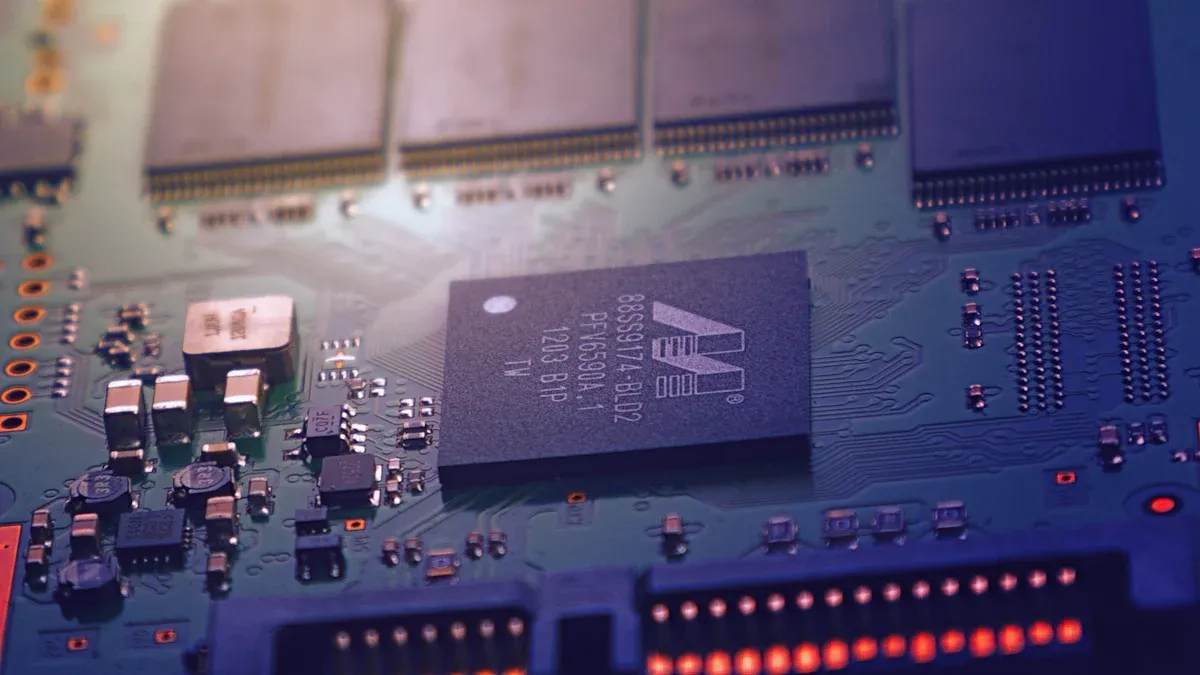
Wearables and IoT
Nordic PMICs play a vital role in the fast-growing market for wearables and IoT devices. The IoT Node and Gateway Market report from MarketsandMarkets highlights strong growth for Nordic Semiconductor’s PMICs, especially the nPM1300, in areas such as wearable devices, IoT sensors, smart home devices, and portable electronics. These PMICs help improve power management efficiency and reduce the bill of materials by integrating multiple components. They also support connectivity IC segments within the IoT ecosystem, making them a popular choice for consumer electronics like smart home and smart appliances.
Nordic Semiconductor demonstrated the Nordic Thingy:91 X platform at CES 2025. This asset tracking device uses the nPM6001 and nPM1300 for power management.
The platform supports LTE-M, NB-IoT, GNSS, and NR+ connectivity, along with Bluetooth LE and Wi-Fi enabled by Nordic’s SoCs.
Nordic’s nRFCloud and nRF Connect SDK provide a complete ecosystem for wearable and IoT device development.
These examples show how Nordic PMICs enable reliable operation and long battery life in connected devices. Their efficient charging features and support for multiple power rails make them ideal for wearables that require frequent charging and stable performance.
Design Simplification
Nordic PMICs simplify device design by combining several power management functions into a single chip. The nPM2100, for example, integrates an efficient boost regulator and energy-saving features that maximize battery usage. Technical reviews confirm that this PMIC supports low-power SoCs and MCUs, such as the nRF52, nRF53, and nRF54 series. Designers can configure advanced functions like ship mode and battery fuel gauging through I2C, which reduces the need for extra components.
Nordic’s product documentation shows that PMICs like the nPM1100, nPM1300, nPM2100, and nPM6001 are optimized for ultra-low power consumption and high integration. These features allow engineers to create more compact and efficient devices. The small size and multifunctionality of these PMICs help reduce board space and lower system costs. Devices benefit from reliable battery charging, advanced charging control, and seamless integration with Nordic’s SoCs.
Tip: By using Nordic PMICs, engineers can speed up development, reduce design complexity, and deliver products with longer battery life and efficient charging.
Overcoming Power Management Challenges
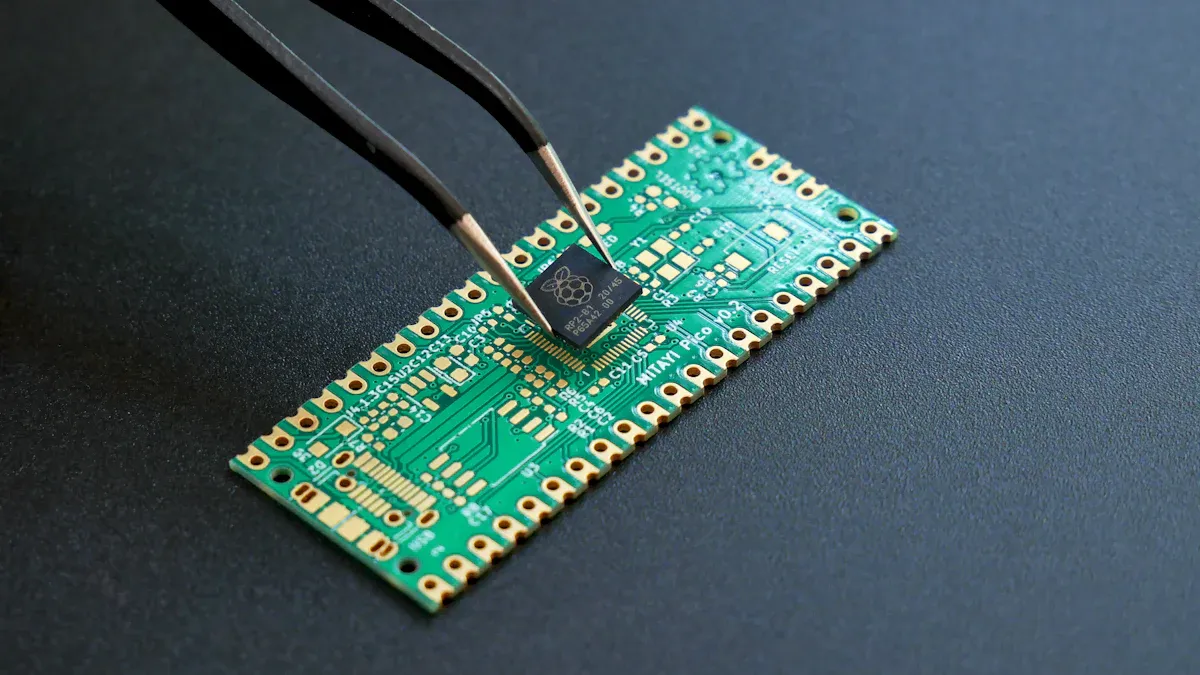
Reliability and Safety
Modern power management solutions must deliver both reliability and safety. Nordic PMICs address these needs by integrating advanced monitoring and protection features. These features include real-time voltage and current monitoring, thermal regulation, and automatic fault detection. Devices can maintain stable operation even when conditions change quickly.
Qorvo’s engineering blog highlights that PMICs using advanced technologies, such as ActiveCiPS™, improve system efficiency and performance. These PMICs help reduce the bill-of-materials cost while keeping devices small and highly efficient. Nordic PMICs follow this approach by offering robust power sequencing and management. Engineers can set up precise sequencing for voltage rails, which ensures that each component receives power in the correct order. This careful sequencing prevents damage and supports safe startup and shutdown routines.
Reliable power management protects sensitive electronics and extends device life. Safety features like watchdog timers and hard resets add another layer of protection.
Nordic PMICs also support energy efficiency by minimizing power loss during sequencing and regulation. This focus on efficiency helps devices meet strict safety and reliability standards in industries like healthcare and wearables.
Development Speed
Engineers often face tight deadlines when designing new products. Nordic PMICs help speed up development by offering flexible configuration tools and software support. Programmable power management features allow engineers to adjust settings for different applications without changing hardware. Qorvo’s blog explains that programmable PMICs with advanced configuration capabilities overcome customization challenges. These solutions streamline the development process and reduce time-to-market.
Nordic PMICs simplify power sequencing and management with user-friendly interfaces. Developers can use graphical tools to set up sequencing, monitor system performance, and optimize energy efficiency. This approach reduces errors and shortens the learning curve for new users.
A table below shows how integrated PMICs improve development speed:
Feature | Impact on Development |
|---|---|
Programmable sequencing | Faster setup |
Software configuration | Quick adjustments |
Integrated monitoring | Easier troubleshooting |
Reference designs | Reduced design time |
Efficient power management and sequencing help engineers deliver reliable products faster. Nordic PMICs support energy efficiency and flexible management, making them ideal for modern devices that require quick development and high performance.
Nordic PMICs deliver strong advantages for modern electronics. Their integrated design boosts efficiency, extends battery life, and simplifies device development. These solutions fit well in compact, low-power products across consumer, automotive, and industrial sectors. Market trends show growing demand for highly integrated, energy-saving PMICs. Nordic’s focus on innovation and energy management positions them for growth as industries move toward smarter, greener technology.
Nordic PMICs help engineers meet future challenges in power management with reliable, efficient solutions.
FAQ
What makes Nordic PMICs – integrated solutions ideal for battery-powered applications?
Nordic PMICs – integrated solutions combine multiple power management functions into one chip. This design saves space and improves energy efficiency. Devices can achieve longer battery life and reliable operation, which is important for battery-powered applications like wearables and IoT devices.
How do Nordic PMICs improve power efficiency and energy conversion efficiency?
Nordic PMICs use advanced circuits and boost regulator technology. These features help manage voltage regulation and power sequencing. Devices can reduce wasted energy and maintain high energy conversion efficiency, which supports longer battery life and better performance.
Can Nordic PMICs support flexible charging and battery charging management?
Yes. Nordic PMICs offer flexible charging options and advanced battery charging management. They support different battery chemistries and provide thermal regulation. Devices can charge safely and efficiently, which helps extend battery life and protect sensitive components.
What role does software play in configuring Nordic power management ICs?
Software tools allow engineers to set up power sequencing, voltage regulation, and monitoring. These tools make it easy to adjust settings for different applications. The process speeds up development and ensures that power management ICs work efficiently in various devices.
How do integrated PMICs simplify device design and development?
Integrated PMICs reduce the number of separate circuits needed on a board. This approach saves space and lowers system costs. Engineers can use reference designs and configuration tools to speed up development and improve reliability in modern electronics.
See Also
Explore The LPQ252-CEF For Optimized Power Control
Enhancing Automotive Performance Using NXP MC9S12X Microcontrollers
Three Best Methods To Integrate MC9S12XET512VAG Effectively
SPC56 Microcontrollers Providing Simplified Engine Control Options
ARTESYN NPT42-M Drives Reliable Industrial Automation Systems
CALL US DIRECTLY
(+86)755-82724686
RM2508,BlockA,JiaheHuaqiangBuilding,ShenNanMiddleRd,Futian District,Shenzhen,518031,CN
www.keepboomingtech.com sales@keepboomingtech.com
